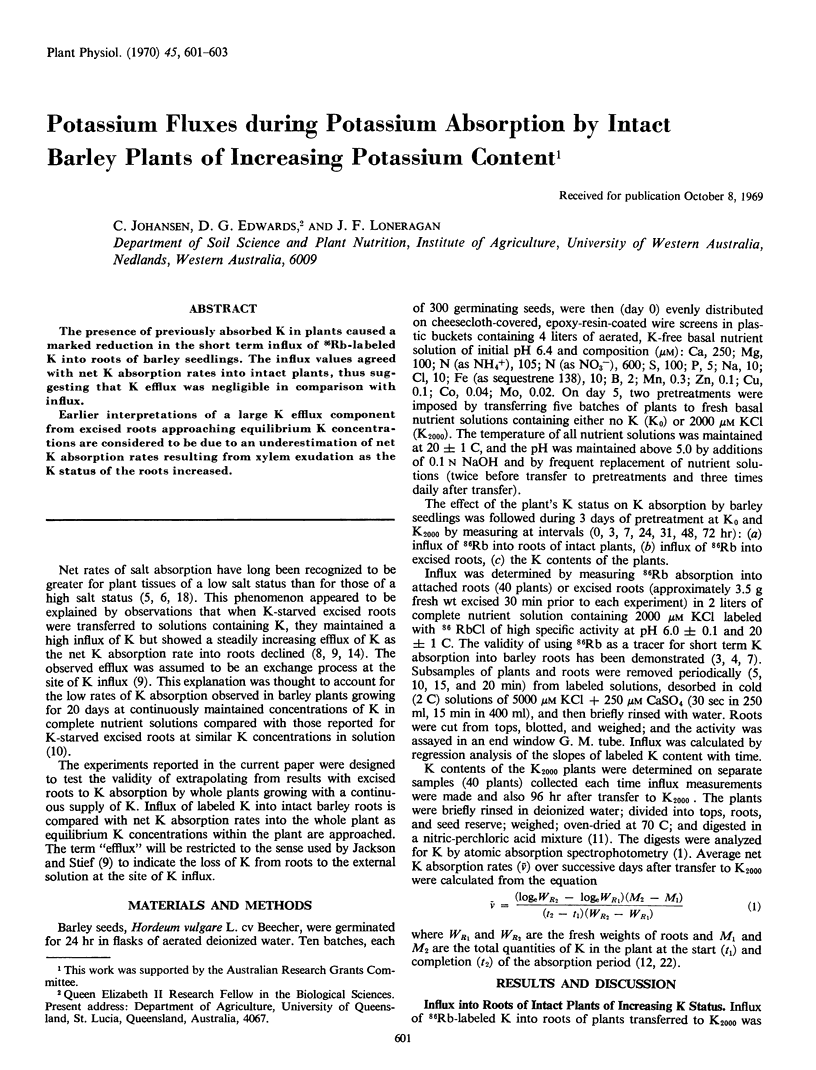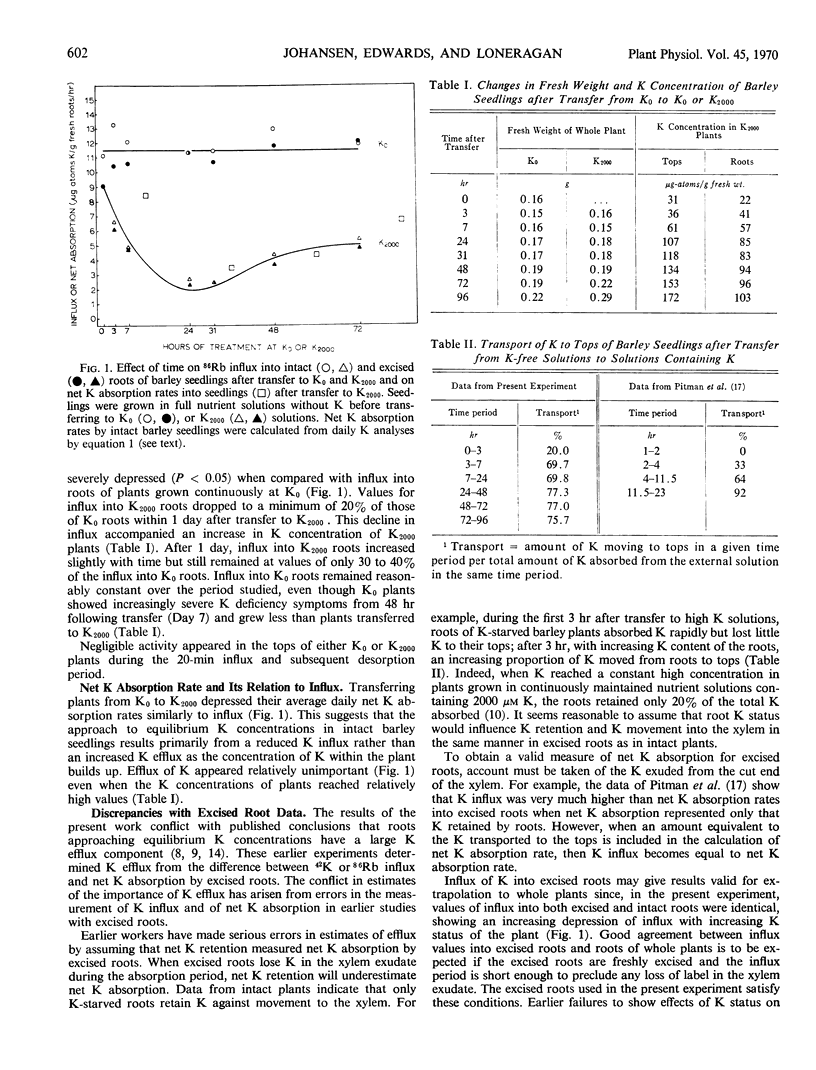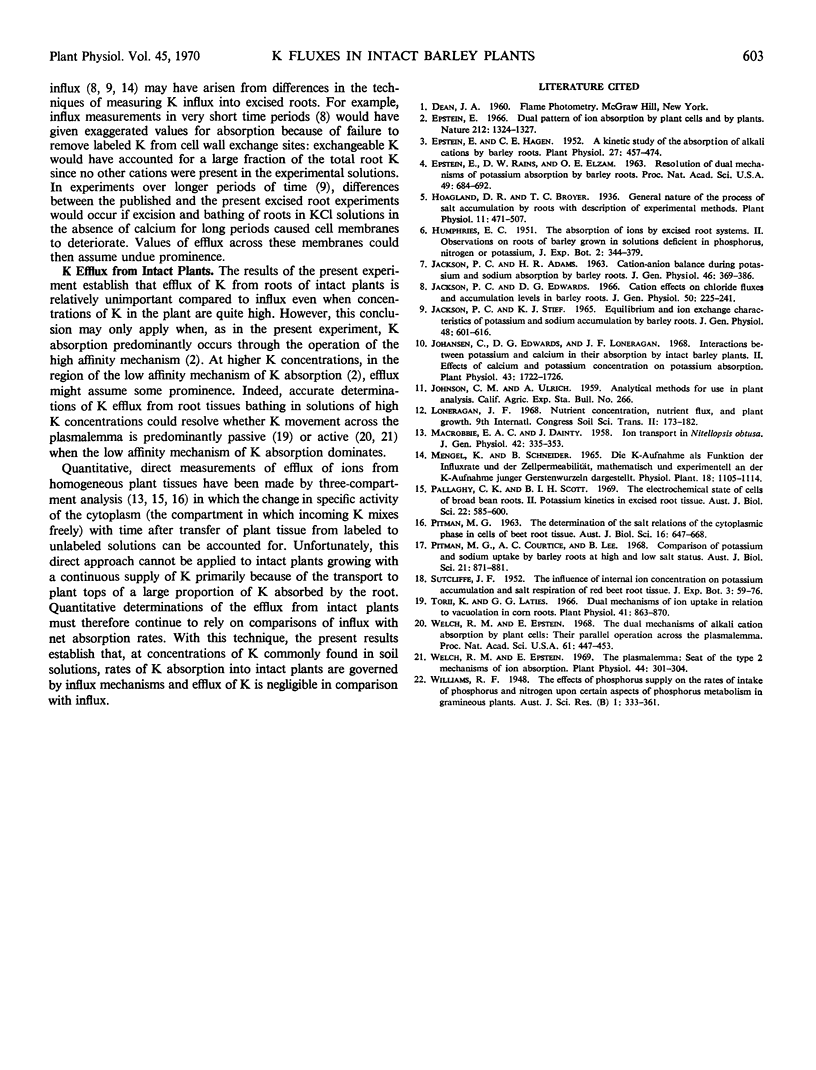Abstract
The presence of previously absorbed K in plants caused a marked reduction in the short term influx of 86Rb-labeled K into roots of barley seedlings. The influx values agreed with net K absorption rates into intact plants, thus suggesting that K efflux was negligible in comparison with influx.
Earlier interpretations of a large K efflux component from excised roots approaching equilibrium K concentrations are considered to be due to an underestimation of net K absorption rates resulting from xylem exudation as the K status of the roots increased.
Full text
PDF


Selected References
These references are in PubMed. This may not be the complete list of references from this article.
- Epstein E., Hagen C. E. A KINETIC STUDY OF THE ABSORPTION OF ALKALI CATIONS BY BARLEY ROOTS. Plant Physiol. 1952 Jul;27(3):457–474. doi: 10.1104/pp.27.3.457. [DOI] [PMC free article] [PubMed] [Google Scholar]
- Epstein E., Rains D. W., Elzam O. E. RESOLUTION OF DUAL MECHANISMS OF POTASSIUM ABSORPTION BY BARLEY ROOTS. Proc Natl Acad Sci U S A. 1963 May;49(5):684–692. doi: 10.1073/pnas.49.5.684. [DOI] [PMC free article] [PubMed] [Google Scholar]
- Hoagland D. R., Broyer T. C. GENERAL NATURE OF THE PROCESS OF SALT ACCUMULATION BY ROOTS WITH DESCRIPTION OF EXPERIMENTAL METHODS. Plant Physiol. 1936 Jul;11(3):471–507. doi: 10.1104/pp.11.3.471. [DOI] [PMC free article] [PubMed] [Google Scholar]
- JACKSON P. C., ADAMS H. R. Cation-anion balance during potassium and sodium absorption by barley roots. J Gen Physiol. 1963 Jan;46:369–386. doi: 10.1085/jgp.46.3.369. [DOI] [PMC free article] [PubMed] [Google Scholar]
- Jackson P. C., Edwards D. G. Cation effects on chloride fluxes and accumulation levels in barley roots. J Gen Physiol. 1966 Sep;50(1):225–241. doi: 10.1085/jgp.50.1.225. [DOI] [PMC free article] [PubMed] [Google Scholar]
- Jackson P. C., Stief K. J. Equilibrium and Ion Exchange Characteristics of Potassium and Sodium Accumulation by Barley Roots. J Gen Physiol. 1965 Mar 1;48(4):601–616. doi: 10.1085/jgp.48.4.601. [DOI] [PMC free article] [PubMed] [Google Scholar]
- Johansen C., Edwards D. G., Loneragan J. F. Interaction Between Potassium and Calcium in Their Absorption by Intact Barley Plants. II. Effects of Calcium and Potassium Concentration on Potassium Absorption. Plant Physiol. 1968 Oct;43(10):1722–1726. doi: 10.1104/pp.43.10.1722. [DOI] [PMC free article] [PubMed] [Google Scholar]
- MACROBBIE E. A., DAINTY J. Ion transport in Nitellopsis obtusa. J Gen Physiol. 1958 Nov 20;42(2):335–353. doi: 10.1085/jgp.42.2.335. [DOI] [PMC free article] [PubMed] [Google Scholar]
- Welch R. M., Epstein E. The dual mechanisms of alkali cation absorption by plant cells: their parallel operation across the plasmalemma. Proc Natl Acad Sci U S A. 1968 Oct;61(2):447–453. doi: 10.1073/pnas.61.2.447. [DOI] [PMC free article] [PubMed] [Google Scholar]
- Welch R. M., Epstein E. The plasmalemma: seat of the type 2 mechanisms of ion absorption. Plant Physiol. 1969 Feb;44(2):301–304. doi: 10.1104/pp.44.2.301. [DOI] [PMC free article] [PubMed] [Google Scholar]


